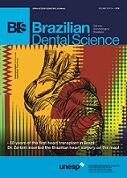Knowledge, Behaviour and Practices regarding Oral Health among Public School Students
DOI:
https://doi.org/10.14295/bds.2018.v21i1.1494Abstract
Objective: The aim of this study was to assess the knowledge, behaviour and practices regarding caries lesions, periodontal disease, preventive measures, diet and oral hygiene among public school students by using specific questionnaire and then guide them on the main educational and preventive methods for oral health. Material and Methods: A total of 376 students aged between 11 and 15 years old were evaluated. The students answered a questionnaire and watched a 10-minute educational video on tooth-brushing techniques, use of dental floss and diet. All the participants were given toothbrushes, dentifrice and dental floss. The resulting data were submitted to descriptive statistical analysis. Results: It was found that 54.26% of the school students were female, 95.21% had knowledge on caries lesions and only 15.96% know about periodontal disease. The surgeon-dentist was pointed out by 66.34% of the students as the responsible for guiding them on oral hygiene, with lack of hygiene being accounted for caries lesions and periodontal disease (64.09% and 38.30%, respectively). Toothbrush, dentifrice and dental floss were the most used resources for oral hygiene by 72.34% of the participants. Dental floss was used by 42.29% of the students, whereas 38.64% fail in doing so claiming they do not know how to use it. Conclusion: The school students showed knowledge on educational and preventive methods for oral health, but with some deficiencies; the majority of them were given guidelines on how to avoid oral problems by a surgeon-dentist; it is necessary to emphasise the importance of using dental floss in educational programs aimed at modifying the students’ behaviour and practices regarding oral health.
Keywords
Dental caries; Education on oral health education; Oral health; Children health; Public health.
Downloads
Downloads
Additional Files
Published
How to Cite
Issue
Section
License
Brazilian Dental Science uses the Creative Commons (CC-BY 4.0) license, thus preserving the integrity of articles in an open access environment. The journal allows the author to retain publishing rights without restrictions.
=================




























